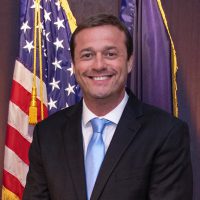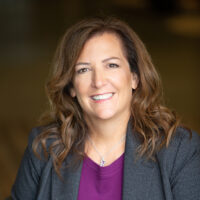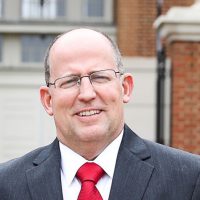Three Republicans with local government experience are vying to become the next mayor of Carmel, a role held by Jim Brainard since 1996. City councilors Kevin “Woody” Rider and Sue Finkam and former Hamilton County Councilor Fred Glynn will face off in the May 2 primary, with the winner set to run against Democrat Miles Nelson in the November general election.
The candidates answered the following questions from Current about how they would lead the city if elected.
Carmel is often criticized for its debt load. Do you believe Carmel has too much debt? Why or why not?

Glynn: The issue of whether the debt is “too much” deserves an objective and honest answer. The mayor has already confirmed there is a lot of debt. Our city has taken on large amounts of debt mostly in the form of tax increment financing. The taxes collected from these developments, usually over a 20-year period, are used to pay back the bond as opposed to funding public services. This only works if the project and supported businesses succeed to pay the taxes that pay back the bond; and if not, taxpayers can be on the hook.
If elected, I will personally continue to study all the documents related to our city’s debt and work on a plan on how to pay down the debt, including the interest-only debt coming due. With our debt service ratio increasing I will also consider a financial audit from an outside firm to come up with a course of action to protect the taxpayers of our city.

Finkam: Carmel’s current debt load is currently at a manageable level. However, the pace at which we’ve been borrowing cannot be continued in future years due to a limited capacity to borrow and potential risks to our revenue, which would create problems for repayment. Moving forward, we need a leader who will not put our residents’ financials, our public safety or our quality of life at risk with overspending, debt, red tape, high taxes and fees. We need a leader who will deliver the very best value to our taxpayers at the lowest possible cost to the taxpayers.

Rider: The conversation about debt in Carmel has turned too political over the years, and I’m committed to ensuring that the conversation turns back towards what matters most: Carmel’s taxpayers and the effect the city’s financial decisions have on them.
Carmel’s debt load is appropriate when compared to revenue, as proven by the city’s AA bond rating. As mayor, I will continue to look for any opportunity to partner with the private sector or use proven financial management techniques to maintain Carmel’s proven record of providing world class services and amenities while protecting our taxpayers.
How should the city balance redevelopment with maintaining the character of surrounding, well-established areas?
Glynn: It is time for our city to turn toward a new chapter of development. That means preserving the green space we have, stopping the endless push for population density with mixed-use development and apartments and concentrating on projects that serve the public at large. More entertainment and dining options downtown would be the best use of the space we have left in that area. We also need to concentrate on maintaining and promoting the character of our neighborhoods that make our great city what it is.
Finkam: We need to change the conversation we have with residents and proactively engage them in the planning process. Additionally, we need to focus not on the size of the redevelopment deals, but rather, the quality of each of them as they relate to their integration into our community and longstanding neighborhoods. We also need to ensure we bring more for-sale housing to the central core of our community and carefully evaluate our capacity for residential product, to not oversaturate the rental market and overburden our infrastructure.
Rider: Redevelopment must remain a focused effort and must include the input of our residents and businesses to make sure that we are utilizing what land is left in the most effective way to meet the ongoing needs of the community. There are areas of Carmel that are appropriate for revitalization or redevelopment, but there are also many areas of our community that need to have their current look and feel preserved. It’s important that as redevelopment opportunities are brought forward to the city, the needs of the community as a whole are balanced with the needs of individual neighborhoods and homeowners.
The city has devoted 1 percent of its general fund to supporting local arts. Is this an appropriate amount and funding source? Why or why not?
Glynn: It is important that we support local arts in our community, and I would support keeping this funding source. Supporting local artists supports local businesses and helps our city gain cultural, social and economic value through the arts.
Finkam: The 1 percent just represents the Mayor’s Arts Grants. The actual percentage is much higher as several million dollars also go to maintain our performing arts campus and related construction bonds.
I would continue the arts grants at this level and would want to work with our arts organizations to determine how we can collectively make them more successful so they can flourish. I would like to bring more citizens to the discussion and create an empowered Arts Commission that will partner with the mayor and city council to complete a Performing Arts Strategy and Public Art Master Plan.
Rider: Local arts are one of the primary differentiators that define Carmel’s place in the region and in the competitive world today. We must continue to invest in the arts, and I am a strong supporter of providing funds from the city budget to provide needed support.
The exact amount of support is something that should be discussed between the administration, city council and arts community. I have supported the 1 percent figure in the past, and I feel that has been an appropriate amount at those times to bridge the gap in funding between private investment in the arts and the needs of the community.
The city has had a couple of failed starts in implementing diversity training and initiatives. How do you think the city should handle diversity training?
Glynn: I can only answer this question based on my own experience with Carmel citizens. What I have seen for myself while knocking on literally thousands of doors is Carmel is a very diverse community. To further affirm Carmel’s cultural diversity, I point to the incredible array of houses of worship as physical symbols of diverse faiths.
In my mind, Carmel’s ethnic, religious and cultural diversity is an affirmation of the open and welcoming community that we are. The majority of these citizens I have spoken to have had positive dealings with our city employees, including our police department. I believe that the employees of our city are good people that judge individuals on the content of their character, work abilities, work ethic and not any ethnic or religious background. As long as we have good people working for us and hire based on merit, this type of initiative will not be necessary. Most general trainings already include this type of training, and we should not need a specialized one.
Finkam: Our terrific city employees have all helped build a beautiful city that has attracted residents representing 78 different countries, speaking 102 languages. As mayor, I want to ensure that when our employees come to work each day, they feel properly equipped to serve our residents and understand their cultural differences. Each employee is pivotal in making this one of the greatest cities in America. Effectively and authentically connecting with people who live in, work and visit our community helps make that possible.
Rider: Carmel has been built on the concept of being non-discriminatory, and I feel it is especially important that city employees, residents and guests feel they are welcome and accepted in our community. Diversity training is a part of that, and as mayor I am committed to ensuring that it is a way of life.
We must hire or contract organizations that are committed to partnering with the city in this mission, and diversity training should be a part of the ongoing training each employee receives. The goal should be to bring education and awareness to all employees about diversity issues that exist or could exist in the city. If an issue arises, it should be handled with compassion and caring for those who are affected. The city and community should learn from past mistakes in order to meet and exceed our goals in the future.
What should be the city’s role in supporting its senior citizen residents and their needs?
Glynn: We need to support affordable retirement options for our seniors that need it so they can live here beyond their working years. We have had these developments built in recent years and should continue to explore where needed. We also need to continue to support organizations like PrimeLife that provide activities and enrichment for the seniors of our community.
Finkam: We need to encourage active aging in our community. Most residents do not want to be confined at home or a retirement center but would rather be active participants in their communities. As this population continues to grow in our city, we need to ensure our physical environment (including our neighborhoods) is accessible, appropriate and affordable social activities are offered and we use technology to keep seniors engaged and involved. As we write Carmel’s next chapter, it is important that seniors’ voices are heard. Additionally, we should partner with PrimeLife Enrichment to develop a long-term strategic plan for sustainability.
Rider: Carmel’s commitment to our senior citizens should be a top priority. We should work together with organizations in the community to ensure that the services seniors need and desire are provided. This includes opportunities for enrichment, education, recreation, and public safety services. Those who have chosen to live out the rest of their lives in our city should be supported, and as mayor I will continue the work that has been done to ensure that residents of all ages have the opportunities to thrive at whatever stage of life they are in.
What is Carmel doing well? What is its area in need of most improvement?
Glynn: Carmel is great place to live because of the people. As long as good people keep wanting to live here, we will continue to be a great community. The things we are doing right to keep good people in our community are good infrastructure, like Keystone Parkway, as well as public safety.
In order to keep good people and attract more in the future we will need to pivot our focus to preserving green space, adding parks and focus on attracting more entertainment options downtown as opposed to continuing the focus on population density and the urbanization of our city. We have laid a good foundation, and it is time to change pace for a better, more resilient city by controlling debt to maintain low taxes in the future. Our future can still be bright!
Finkam: Carmel excels with its schools, roads, placemaking and quality of life. We offer incredible amenities with a low cost of living and low tax rate. I believe our biggest opportunity is to bring the public to the planning table to create a community-driven vision built upon fiscal discipline and communication. As mayor, I will prioritize transparency and community engagement to ensure every resident has a voice in Carmel’s financial future. Together, we will put forth a plan that prioritizes essential services, supports our outstanding quality of life and amenities, balances our budget and better prepares us for the future.
Rider: Carmel’s core services are second to none. I’m proud of the job that city employees do to ensure Carmel is a thriving community. This includes our public safety professionals who work tirelessly to ensure that Carmel is a safe community. Carmel’s elected officials should support those efforts and ensure that taxpayer services are always the number one priority.
A lot of residents talk to me about the need for more communication from the city. As mayor, I’m committed to increasing communication and transparency to ensure that every resident has trust in how their government is working for them.



